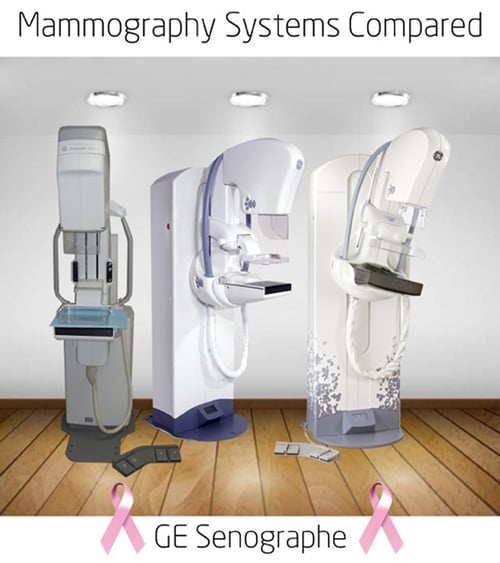It’s October, which means it’s Breast Cancer Awareness Month—and there’s no better time for a discussion about how to choose your next digital mammography system. The good news is, you don’t have to buy a new one—there is a wide range of pre-owned  and refurbished digital mammography equipment on the market that can serve your clinic, hospital or practice.
and refurbished digital mammography equipment on the market that can serve your clinic, hospital or practice.
Let’s take a look at three systems from the GE Digital Mammography lineup. All three offer accurate dose efficiency, digital connectivity, image quality and quick and comfortable positioning. But there are some differences:
The GE Senographe 2000D Mammography System was first introduced in 2000. It was GE’s first foray into full-field digital mammography and incorporated GE’s Revolution digital flat panel detector. The detector is smaller than the newer models on the market, but does deliver superior image quality to the analog predecessors. The GE Senographe 2000D is an upgradable platform that lets you perform a wide array of breast procedures including in-office screening, mobile screening and advanced diagnostic and interventional procedures.
This is an ideal choice for low volume centers. While the unit will have to be re-positioned for larger-breasted patients, it can definitely do the job. Here are the basics:
- Detector size is 18x24cm
- Image size: 1914 x 2294 pixels (9MB)
- Bi-metal anode tube
- Cables link gantry, generator, and the control console (for placement in separate rooms)
- Acquisition bit depth: 14 bits
- Power: 5kW max.
- Ripple: <4% from peak to peak
Let’s move on to the GE Senographe DS Mammography System
This unit was introduced in 2004 and was designed to offer screening, diagnosis and interventional capabilities, all rolled into one system. It has a small footprint and also includes stereotactic options. Basics include:
- Detector size: 19.2 x 23 cm
- Detector matieral: amorphous silicon
- Image size: 1914 x 2294 pixels (9MB)
- Acquisition dynamic range: 14 bits
- Automated gantry
- Pixel size (pitch): 100 μm
- Optional stereotaxy capability
- Tube technology: Uses Anode target materials – Molybdenum / Rhodium dual tube track
The GE Senographe Essential Mammography System
This full-field system was originally introduced in 2006 as GE Healthcare’s flagship digital mammography system. It’s an upgradeable platform that allows you to provide high quality care by performing a wide variety of breast procedures—from in-office or mobile screening to advanced diagnostics. It offers a high throughput with one of the industry’s largest field of view—24 X 31 cm. You can also choose a standard field of view of 19 X 23 cm. It also allows you to get quick and easy patient positioning. Pre-set gantry positioning enables quick angle setting and automatic gantry rotation. You also get great reliability, with 85% of contracted Senographe Essential detectors that were installed in 2006 still being in service in 2014! You get a dual-track x-ray tube that delivers an optimal X-ray spectrum so you penetrate breast thickness. You also get eContrast for improved structure visibility, which is great for implants and stereo images. And you’ll appreciate the independent conversion detector with a Csl scintillator on an amorphous Silicon flat panel for efficient imaging at low dose.
There are two types of detectors that are largely interchangeable: The LFOV1 Detector is 19 X 23 cm. It costs more to replace new. The LFOV2 Detector measures 24 X 31 and costs less to replace new. Both can be bought on the used market for considerably less, though each lasts approximately five years.
The system can be integrated with a biopsy system, as well as a 3D Tomosynthesis tool, (3D Mammography), which provides multiple images in seconds for improved screen and diagnostic breast imaging.
Remember, there is a difference between buying new, refurbished or used. New is nice, but can be cost prohibitive. Refurbished is great, because you usually get a warranty for parts and service. Used can be your least expensive option, but these systems are often sold without a warranty. You don’t know exactly what you’re getting into, and it could end up costing you more.
If you’re not sure which digital mammography system would be best for your practice, talk to an expert from Atlantis Worldwide. We can help you determine which system will fit your facility, as well as the needs of your practice. We’re here to help! Contact us today!
On a final note, please encourage all the women in your life to schedule their annual exam and/or mammography this month. Our hope is that one day, October will just be a month for celebrating Halloween, instead of Breast Cancer Awareness!
Some blogs you may have missed:
- 3D Tomosynthesis, Breast MRI or Digital Mammography?
- Physicians & Social Media: Yay or Nay?
- Free Women Health Resources
- 13 Ways to Decontaminate Medical Imaging Equipment & Protect Staff
- 3D Printing in Medical Imaging & Healthcare
Meet the author: Vikki Harmonay



